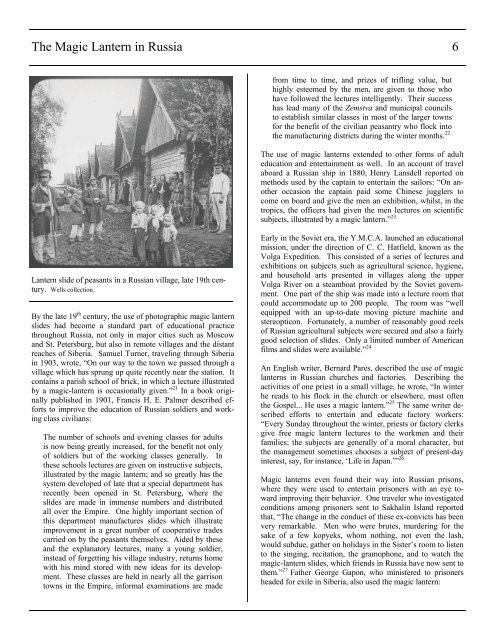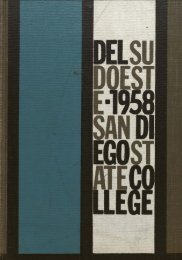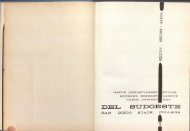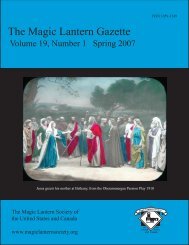The Magic Lantern in Russia - Library
The Magic Lantern in Russia - Library
The Magic Lantern in Russia - Library
You also want an ePaper? Increase the reach of your titles
YUMPU automatically turns print PDFs into web optimized ePapers that Google loves.
<strong>The</strong> <strong>Magic</strong> <strong>Lantern</strong> <strong>in</strong> <strong>Russia</strong> 6<br />
from time to time, and prizes of trifl<strong>in</strong>g value, but<br />
highly esteemed by the men, are given to those who<br />
have followed the lectures <strong>in</strong>telligently. <strong>The</strong>ir success<br />
has lead many of the Zemstva and municipal councils<br />
to establish similar classes <strong>in</strong> most of the larger towns<br />
for the benefit of the civilian peasantry who flock <strong>in</strong>to<br />
the manufactur<strong>in</strong>g districts dur<strong>in</strong>g the w<strong>in</strong>ter months. 22<br />
<strong>The</strong> use of magic lanterns extended to other forms of adult<br />
education and enterta<strong>in</strong>ment as well. In an account of travel<br />
aboard a <strong>Russia</strong>n ship <strong>in</strong> 1880, Henry Lansdell reported on<br />
methods used by the capta<strong>in</strong> to enterta<strong>in</strong> the sailors: “On another<br />
occasion the capta<strong>in</strong> paid some Ch<strong>in</strong>ese jugglers to<br />
come on board and give the men an exhibition, whilst, <strong>in</strong> the<br />
tropics, the officers had given the men lectures on scientific<br />
subjects, illustrated by a magic lantern.” 23<br />
<strong>Lantern</strong> slide of peasants <strong>in</strong> a <strong>Russia</strong>n village, late 19th century.<br />
Wells collection.<br />
By the late 19 th century, the use of photographic magic lantern<br />
slides had become a standard part of educational practice<br />
throughout <strong>Russia</strong>, not only <strong>in</strong> major cities such as Moscow<br />
and St. Petersburg, but also <strong>in</strong> remote villages and the distant<br />
reaches of Siberia. Samuel Turner, travel<strong>in</strong>g through Siberia<br />
<strong>in</strong> 1903, wrote, “On our way to the town we passed through a<br />
village which has sprung up quite recently near the station. It<br />
conta<strong>in</strong>s a parish school of brick, <strong>in</strong> which a lecture illustrated<br />
by a magic-lantern is occasionally given.” 21 In a book orig<strong>in</strong>ally<br />
published <strong>in</strong> 1901, Francis H. E. Palmer described efforts<br />
to improve the education of <strong>Russia</strong>n soldiers and work<strong>in</strong>g<br />
class civilians:<br />
<strong>The</strong> number of schools and even<strong>in</strong>g classes for adults<br />
is now be<strong>in</strong>g greatly <strong>in</strong>creased, for the benefit not only<br />
of soldiers but of the work<strong>in</strong>g classes generally. In<br />
these schools lectures are given on <strong>in</strong>structive subjects,<br />
illustrated by the magic lantern; and so greatly has the<br />
system developed of late that a special department has<br />
recently been opened <strong>in</strong> St. Petersburg, where the<br />
slides are made <strong>in</strong> immense numbers and distributed<br />
all over the Empire. One highly important section of<br />
this department manufactures slides which illustrate<br />
improvement <strong>in</strong> a great number of cooperative trades<br />
carried on by the peasants themselves. Aided by these<br />
and the explanatory lectures, many a young soldier,<br />
<strong>in</strong>stead of forgett<strong>in</strong>g his village <strong>in</strong>dustry, returns home<br />
with his m<strong>in</strong>d stored with new ideas for its development.<br />
<strong>The</strong>se classes are held <strong>in</strong> nearly all the garrison<br />
towns <strong>in</strong> the Empire, <strong>in</strong>formal exam<strong>in</strong>ations are made<br />
Early <strong>in</strong> the Soviet era, the Y.M.C.A. launched an educational<br />
mission, under the direction of C. C. Hatfield, known as the<br />
Volga Expedition. This consisted of a series of lectures and<br />
exhibitions on subjects such as agricultural science, hygiene,<br />
and household arts presented <strong>in</strong> villages along the upper<br />
Volga River on a steamboat provided by the Soviet government.<br />
One part of the ship was made <strong>in</strong>to a lecture room that<br />
could accommodate up to 200 people. <strong>The</strong> room was “well<br />
equipped with an up-to-date mov<strong>in</strong>g picture mach<strong>in</strong>e and<br />
stereopticon. Fortunately, a number of reasonably good reels<br />
of <strong>Russia</strong>n agricultural subjects were secured and also a fairly<br />
good selection of slides. Only a limited number of American<br />
films and slides were available.” 24<br />
An English writer, Bernard Pares, described the use of magic<br />
lanterns <strong>in</strong> <strong>Russia</strong>n churches and factories. Describ<strong>in</strong>g the<br />
activities of one priest <strong>in</strong> a small village, he wrote, “In w<strong>in</strong>ter<br />
he reads to his flock <strong>in</strong> the church or elsewhere, most often<br />
the Gospel... He uses a magic lantern.” 25 <strong>The</strong> same writer described<br />
efforts to enterta<strong>in</strong> and educate factory workers:<br />
“Every Sunday throughout the w<strong>in</strong>ter, priests or factory clerks<br />
give free magic lantern lectures to the workmen and their<br />
families; the subjects are generally of a moral character, but<br />
the management sometimes chooses a subject of present-day<br />
<strong>in</strong>terest, say, for <strong>in</strong>stance, ‘Life <strong>in</strong> Japan.’” 26<br />
<strong>Magic</strong> lanterns even found their way <strong>in</strong>to <strong>Russia</strong>n prisons,<br />
where they were used to enterta<strong>in</strong> prisoners with an eye toward<br />
improv<strong>in</strong>g their behavior. One traveler who <strong>in</strong>vestigated<br />
conditions among prisoners sent to Sakhal<strong>in</strong> Island reported<br />
that, “<strong>The</strong> change <strong>in</strong> the conduct of these ex-convicts has been<br />
very remarkable. Men who were brutes, murder<strong>in</strong>g for the<br />
sake of a few kopyeks, whom noth<strong>in</strong>g, not even the lash,<br />
would subdue, gather on holidays <strong>in</strong> the Sister’s room to listen<br />
to the s<strong>in</strong>g<strong>in</strong>g, recitation, the gramophone, and to watch the<br />
magic-lantern slides, which friends <strong>in</strong> <strong>Russia</strong> have now sent to<br />
them.” 27 Father George Gapon, who m<strong>in</strong>istered to prisoners<br />
headed for exile <strong>in</strong> Siberia, also used the magic lantern:

















